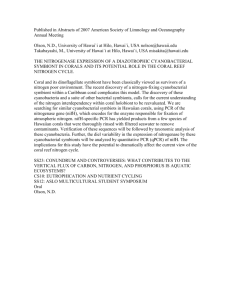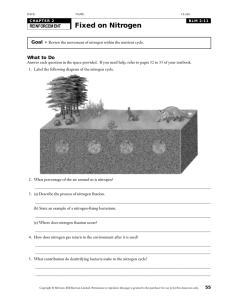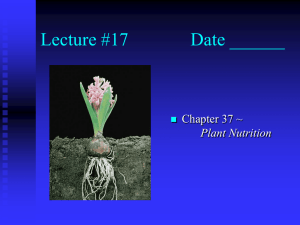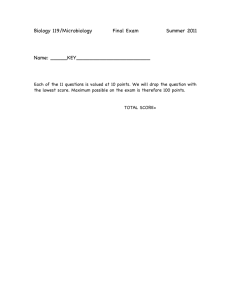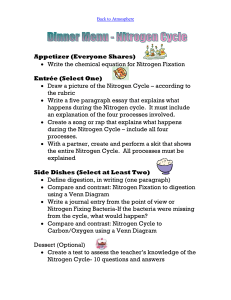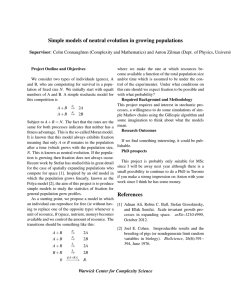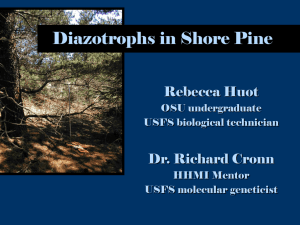Nitrogen Fixation by Symbiotic and Free-Living Spirochetes
advertisement
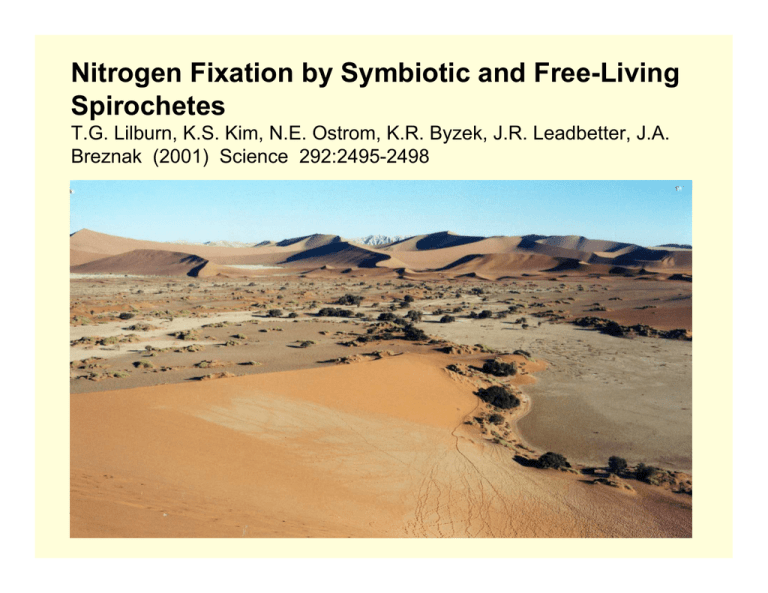
Nitrogen Fixation by Symbiotic and Free-Living Spirochetes T.G. Lilburn, K.S. Kim, N.E. Ostrom, K.R. Byzek, J.R. Leadbetter, J.A. Breznak (2001) Science 292:2495-2498 http://www.worldatlas.com/ Nitrogen Fixation by Symbiotic and Free-Living Spirochetes Exploratory/Hypothesis ZAS-1, ZAS-2 and ZAS-9 (phylogenetically related to the Treponemes) Nitrogen fixation? nifH and ability to fix N2 Spirochetes the likely origin of certain nifHs in termite guts and perhaps in other environments? Kingdom:Animalia Phylum:Arthropoda Class:Insecta Order:Isoptera Families: Mastotermitidae Kalotermitidae Termopsidae Hodotermitidae- Zootermopsis angusticollis (pacific dampwood termite) Rhinotermitidae Serritermitidae Termitidae Termites and Nitrogen • • • • Decomposers-lignocellulosic plant material Gut microbiota is dense and diverse Biogeochemical (nutrient) cycling-Carbon, Nitrogen. Release of energy Bigger role in N cycling than previously thought www.epa.gov/maia/images/nitro.jpg Termites and Nitrogen Nitrogen poor diet Symbiotic interactions with gut microbes to augment nitrogen economy -Recycling of excretory products -Nitrogen fixation 60% of nitrogen from N2 fixation Few strains: -Citrobacter freundii, Pantoea agglomerans, and Desulfovibrio spp. ? N2 fixation Survey for nifH in termite guts implied that diversity of N2 fixing microbes was much greater than by culture isolation and most of the a.a. sequences of NifH were different from known microbial taxa. Nitrogenase and nifH N2 + 8e- + 8H+ + 16ATP ⇒ 2NH3 + H2 + 16ADP + 16Pi Organisms that are capable of fixing atmospheric dinitrogen (N2) possess the enzyme nitrogenase, which reduces N2 to ammonia (NH3), a product that is subsequently assimilated into biomass. Such organisms have access to a ubiquitous source of nitrogen. Nitrogenase is found in prokaryotic organisms, including many species of cyanobacteria. Nitrogenases catalyzes the reduction of not only dinitrogen, but also a variety of other substrates Nif genes found in free-living and Symbiotic nitrogen fixers nifH encodes nitrogenase Iron protein subunit www.jic.bbsrc.ac.uk/staff/simon-george/ Nitrogenase synthesis can be repressed in the presence of NH4+ in medium http://www.rcsb.org/pdb/explore.do?structureId=1NIP PDB Nitrogenase Fe Azotobacter vinelandii Acetylene reduction assay (AR) Measure nitrogenase activity. Nitrogenase can use other substrates with triple bonds -Gaseous Nitrogen N≡N (converted to NH3) - Acetylene HC ≡CH (converted to CH2=CH2) The use of nitrogenase-catalyzed reduction of acetylene (C2H2) to ethylene (C2H4) as a sensitive and simple assay to measure biological nitrogen fixation. ARA owes its popularity to its low cost, sensitivity and fast response time. Image courtesy: John Breznak, Michigan State University Diversity of termite gut spirochetes Role of Spirochetes in N2 Fixation? •Free living or host associate helical bacteria •Class Spirochaetes Order Spirochetales Familes: -Spirochaetaceae w/genera:Treponema, Borrelia, Brevinema, Cristispira, spirochaeta -Brachyspiraceae -Leptospiraceae •50% of gut microbes are spirochetes Role of Spirochetes in N2 Fixation? • Previously Isolated strains ZAS-1, ZAS-2, and ZAS-9 (in genera Treponema) • Acetogenesis: 4 H2 + 2 CO2 --> CH3COOH + 2 H2O • First, examined gDNA for presence of nifH -nifH encodes a nitrogenase enzyme -catalyzes the reduction of N2 to NH3 (ammonia) which can then be assimilated to biomass • Second, examined their ability to fix N2 -Using the acetylene reduction assay (developed in the late 1960s by Stewart et al. (1967; 1968) and hardy et al. (1968). -Grow spirochetes under different gases 15N2, Ar, N2/CO2, Ar/CO2 Presence of nifH? •Two nifH homologs in each termite gut treponeme •nifH homologs found in other treponemes •A.A. seq. of NifH had motifs most like iron nitrogenase •NifHs were phylogenetically diverse and not congruent with spirochete phylogeny based on 16S rRNA sequences •No nifH found in halophile spirochete, swine pathogen, syphilis, or lyme disease spirochete Fig. 2 Phylogenetic tree of NifH sequences from Spirochetes, other prok/termite gut, enviro. 15N/15N used 2 89.0129/99.30 15N/Exp15N 6.3789/38 •SA of nitrogenase in S. aurantia was sufficient to provide virtually all the N needed by cells during exponential growth on N2. Could not grow S. zuelzerae or ZAS-9 w/o YA. •15N content of ZAS-9 was less than that for S. aurantia b/c diluted by 14N from YA. Has less 15N, implies that N2 fixation enabled cells to assimilate nitrogenous compounds in YA •Same for S. zuelzerae, SA is low, would only supply 20% of N needed for each doubling in biomass. Suggest that nitrogenase activities are probably not max. attainable by cells. S. aurantia ZAS-9 +YA •All show N2 dependent growth, and NH4+-repressible AR activity •ZAS-9 & S. zuelzerae could not be grown w/o YA (source of fixed N) •Can still see N limited growth in these organisms by using media w/2% YA w/no added NH4Cl. AR activity commenced with the onset of N2 dept. growth •ZAS-1, ZAS-2 revealed no enhancement of growth in N2 and little nitrogenase activity. S. zuelzerae +YA Authors Conclusions Show spirochetes can be N2-fixers S. aurantia, ZAS-9, S. zuelzerae highly correlated nifH presence and nitrogen fixation Spirochetes have a role in termite nitrogen nutrition -50% of prokaryotes in gut are spirochetes, -spirochete NifHs were identical to NifH clones from a variety of termites Potential contribution of spirochetes to N2 fixation might be very high in termite guts. KO spirochetes = decreased termite survival Free-living spirochetes may contribute substantially to N2 fixation in a variety of habitats. Questions?
